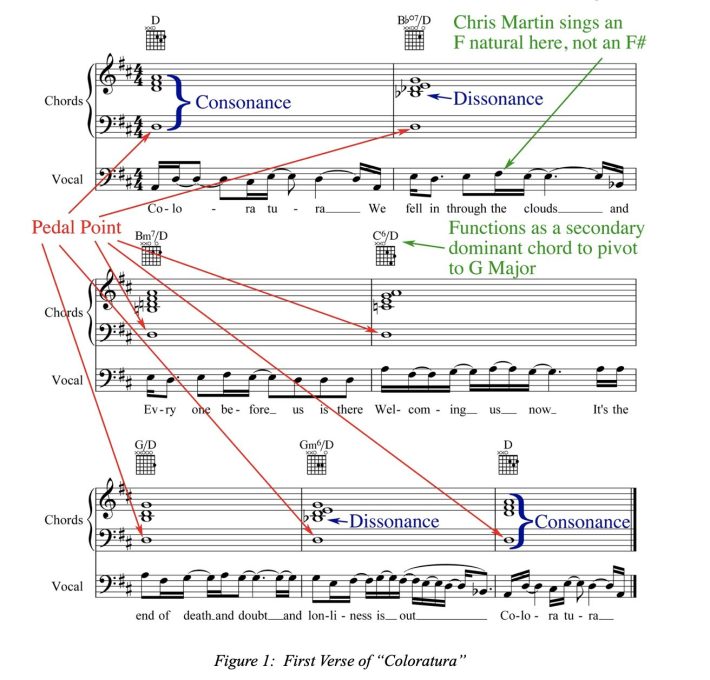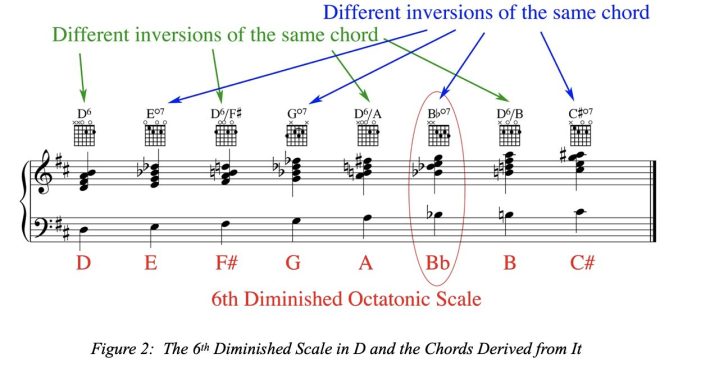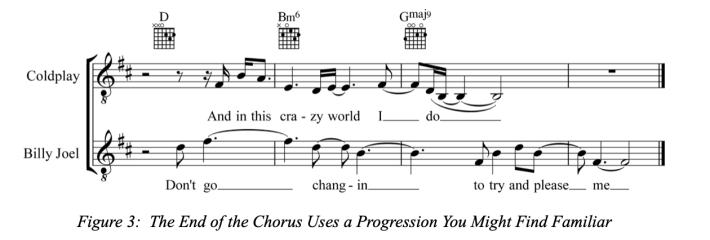Vivek Maddala is an Emmy-winning composer and a regular participant in The Number Ones Comment Section. After reading his takes on the music theory behind several historic hits, we invited him to turn his focus on more current singles. Welcome to our new column In Theory.
In advance of the release of Coldplay’s new album, Music Of The Spheres, the band has put out two new songs: the rather unimpressive "Higher Power," and the remarkably stirring "Coloratura." The latter is an epic 10-minute pop oddity with a lot going on compositionally. I’ve always been rather indifferent to the music of Coldplay... until I heard this tune.It's truly stunning, so let's check it out.
In the tradition of 17th-Century European opera, coloratura is a florid vocal ornamentation of a melody using trills, mordents, and leaps. (The word means "coloring" in Italian and comes from the Latin infinitive colorare.) It’s similar to gamakas in South Indian Carnatic music, and to melismatic singing in pop tunes (think Whitney Houston's vocal decorations in the song "I Will Always Love You"). Among musicians, the word coloratura often conjures an opera singer using agile runs to hit high notes.
So how does Coldplay deploy this musical construct in their song? Well, they don't. Perhaps I'm straining credulity here, but Chris Martin et al are probably using the coloratura concept metaphorically: Since their song is partly an ode to celestial bodies and the cosmos, maybe they're simply invoking the idea of reaching to the heavens the way a coloratura soprano reaches for the high F, two octaves and a fourth above middle C. This conceit may be farfetched, but it’s the best I can come up with. In short, there’s no actual coloratura in Coldplay's song.
Structure
The Coldplay recording contains heavily sound-designed instrumental sections, including an evolving, nearly two-minute intro and a two-and-a-half-minute interlude (which comprises distinctive movements within itself). The song isn't really through-composed though, because there are recurring musical motifs threaded throughout. At the core is a more familiar verse-chorus type of structure we all know. Despite all the buzz around the quasi-prog instrumental sections, the composition of the vocal sections is what’s most compelling and what I'd like to examine here.
"Coloratura" opens with the sound of an orchestra tuning up -- notably, to A440 concert pitch. This is significant because it anchors the song to the most common tuning standard used in North America and the UK, standing in contrast to many of Coldplay’s best-known songs (e.g., "Yellow," "The Scientist"), which are tuned sharp -- as much as 30 cents in some cases.
Pedal This
About one minute in, the song establishes its most essential, defining feature: the pedal point. You can hear it in the piano and harp motif that comes in at 1:05 and when it frames the vocal melody starting at 1:48. Pedal points are fixed bass notes played beneath shifting chords and melodies, in order to create tension and release. There are innumerable examples of pedal points in European classical music (Bach's Toccata And Fugue In D Minor being one of the most famous), and the pedal point is a central characteristic of Indian ragas (it's the "drone" played by a tambura that establishes the raga's modal foundation). In bebop and modal jazz, the pedal point is a powerful device -- e.g., in John Coltrane’s "Naima," a ballad in A♭ Major, where the 5th scale degree (E♭) serves as the pedal point through most of the song, creating a sense of longing, an aching to resolve to the tonic. Prog-rock band Genesis is legendary for their use of pedal points (particularly in the Peter Gabriel era), and Boston prominently used a low-F quarter-note pedal point in "Long Time." The opening to the Who’s "Pinball Wizard" and Van Halen's "Jump" and "I'll Wait" are also examples -- and there are countless more throughout the pop music canon.
Coldplay's use of the pedal point in "Coloratura" is a textbook example of this musical device insofar as the passage begins with consonance, travels through varying degrees of dissonance, and returns to consonance. The chords themselves tell a story that obliquely channels principles of Newtonian physics: A body is initially at rest, then has force applied to it (musical dissonance) to overcome inertia and move through space (chord changes). The body then returns home as it is pulled back by a gravitational force (the ever-present pedal point). See Figure 1 below.
Why does this work so well? The bass note, "D," is the pedal point, and even though it stays constant throughout the verse, it acquires a different meaning under each chord.With the first chord, the pedal point is home, at rest. Under the B♭ diminished chord, the pedal point struggles to bind the harmony because the chord’s D♭ note creates a half-step dissonance with it, and the chord’s B♭ note creates a half-step dissonance with the pedal’s implied 5th interval (the note A). As the verse continues, we hear varying amounts of tension and release as the pedal interacts with the chords on top of it. The passage builds expectation because the pedal point restrains the harmony, holding it down.We can feel it percolating, struggling to break free. As we experience this tension, magnificent as it is, a part of us wants the chords to separate from the pedal point and express themselves in a more unchained manner. At the 2:40 mark, when the chorus finally arrives and we hear the IV chord (GMaj9), it feels like a huge relief because the pedal point finally releases, creating an enormous lift. This heightened sense of drama in the chorus is why people have been drawing comparisons between "Coloratura" and Pink Floyd's "Brain Damage" and "Comfortably Numb." (Jonny Buckland's double-tracked guitar solo coming out of the instrumental interlude has been compared to David Gilmour's solos, and I understand why. While Buckland’s solo may not possess the exquisite phrasing and lyrical melodic turns of Gilmour's solos, he’s channeling a similar vibe.)

The 6th Diminished Scale
Diving a bit deeper into the song’s verse: The most compelling aspect is the second chord, what I'm calling the B♭o7/D ("B♭-diminished-7-over-D"). It's possible Coldplay is using a simpler variation of the chord here -- a Gmin6/D -- which is the same chord in this context except with an implied D♭, rather than an explicitly stated one. In any case, the B♭o7/D is way cooler, and it's what I think I'm hearing when I listen to the song -- so let's go with that. Where does this chord come from, and why does it invoke a romantic yearning feeling?There's a bebop concept that legendary jazz pianist and educator Barry Harris has popularized, called the "6th Diminished Scale." The second chord in Coldplay's "Coloratura" comes from this concept.
Diatonic chords, by definition, live in the song's key center. In the key of D Major (the ostensible key center of "Coloratura"), the diatonic chords would be DMaj7, Emin7, F#min7, GMaj7, A7, Bmin7, and C#min7♭5 (or C#-half-diminished-7). These chords are derived from harmonizing the Major scale by stacking 3rds in order to generate 4-note chords. (For more background on this concept, check out my previous article on Lorde’s "Solar Power.")
We can consider the B♭o7 to be a non-diatonic chord to the extent that we’re following the D Major scale. However, that chord lives comfortably in the 6th Diminished scale, as shown in Figure 2.

Essentially, the scale is identical to the standard heptatonic (7-note) D Major ("Ionian") scale, but with an added flat-6 degree, making it an octatonic (8-note) scale. Specifically, it is the added flat-6th degree that gives us the transcendent B♭o7/D used in the second bar of each verse of "Coloratura." This scale and associated chords are fundamental in bebop (a la Charlie Parker) and in so-called Gypsy jazz (a la Django Reinhardt). But the scale and harmony derived from it trace back at least as far as the Romantic period of European classical music (circa 1830-1900), a period marked by expansive, expressive symphonic writing.
To wit: You can hear the harmonic movement that Coldplay uses in the opening bars of the vocal section of "Coloratura" in Chopin’s Nocturne Op.9 No.2. The haunting quality of this modulation, i.e., going from the I (tonic) to the ♭vio/I (flat-6-diminished over I), imparts the same aching emotion in both pieces. You can also hear it in various works by Tchaikovsky, and I have used this modulation in my own compositions to achieve a similar dramatic effect -- e.g., in the recurring romantic theme in the score for the film Wild Oranges. As with the other examples, Coldplay's use of the B♭o7/D chord imparts a feeling of longing because the B♭ note wants to resolve down to the A (the perfect 5th in D); the D♭ wants to resolve up to the D; the E wants to resolve either down to D or up to F# (the Major 3rd interval in D); and the G wants to resolve down to the F#.The chord is quite unstable and strongly desires resolution back to the tonic, as though being pulled by a magnetic field. (For more background on how this works, again refer back to "Solar Power" and see the "First Principles" explanation in that analysis.)
It's remarkable that Coldplay decided to use such a bold, harmonically rich progression in the context of today’s pop music environment (marked by harmonic simplicity and rigid adherence to diatonic chords). Good for them -- and good for us, as listeners.
Mixed Meter And Mode
The instrumental interlude between vocal sections contains some wondrous musical turns. The song briefly detours into Lydian mode, where we hear a G# in the harmony with chords shifting once again over a D pedal. Previously, we discussed how the raised 4th degree in Lydian mode creates a sense of hope and uplift, and in "Coloratura" it serves to invoke a sensation of flying. This is followed by a secondary dominant (E7) and a series of surprising modulations involving chromatic ascensions and descensions, through an augmented chord (D+/E), and eventually pivoting into the V chord (F#7) of a new passage in B minor. Here, things get even more curious.
This delicate new chapter in the song follows 6/4 meter, with celeste, glockenspiel, and synth textures playing an ostinato pattern that creates a floating feel. It leads to a delightful surprise: a kind of swung waltz with three bars of 5/4 and one bar of 6/4, repeating on a IV-V-vi-iii chord progression. They're not exactly channeling Dave Brubeck, but it's a lovely passage and it could form the basis of a whole other song -- one I'd be up for hearing, were it to exist. The last cycle of this chord progression lands on another secondary dominant, the F#7 -- which is the III chord in D (or the V of vi in D).
Don’t Go Changing...Or Do Go Changing...?
Bringing us back to the anthemic final chorus is the aforementioned David Gilmour-lite guitar solo, playing the same chord changes. The diatonic IV-I-vi-IV-ii progression serves the chorus well, and its "primary colors" mark a satisfying contrast to the chromaticism of the verses. The tastiest bit happens at the end of the choruses, with a poignant coda to wrap up our space odyssey. Do the chords in the closing passage sound familiar to you? See Figure 3.

The conclusion of the chorus is especially tender given its use of the vi6 chord -- a Bmin6 -- which is an inversion of the #IVmin7♭5 (a G#min7♭5), or half-diminished chord. Minor-6 chords, and related minor-7-flat-5 chords, invoke a moody complexity, the exploration of which could be a good subject for another column. Minor-6 (and minor-7-flat-5) chords are enormously valuable tools for summoning the feeling of pensive dissonance. These chords contain both the most comforting (perfect 5th) and most jarring (tritone) intervals that exist in traditional Western harmony -- resulting in something that is emotionally murky, but with an inherent ambiguity that can be riveting to the listener. Indeed, in “Coloratura,” the Bmin6 chord provides a brooding quality with a gentle, warm resolution on the lyrics "In this crazy world, I do... I just want you." Well done, Coldplay.
"Coloratura" is an ambitious undertaking, and I commend the band, along with producer Max Martin and additional personnel cited as writers, for eluding the current trend of harmonic simplicity. There’s a paucity of emotional richness in much of today's pop music, but Coldplay and a few others (Billie Eilish and Bruno Mars/Anderson .Paak come to mind) are doing their part to make up for the deficit. In short, maybe I misjudged Coldplay... If this song foreshadows a new era for the band, I look forward to it.






